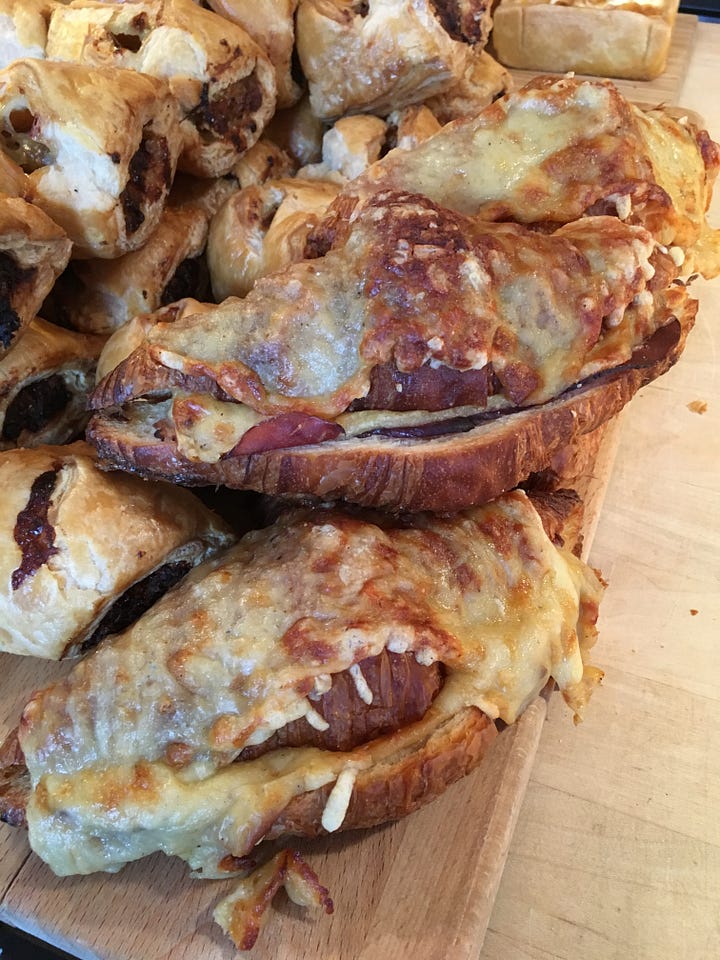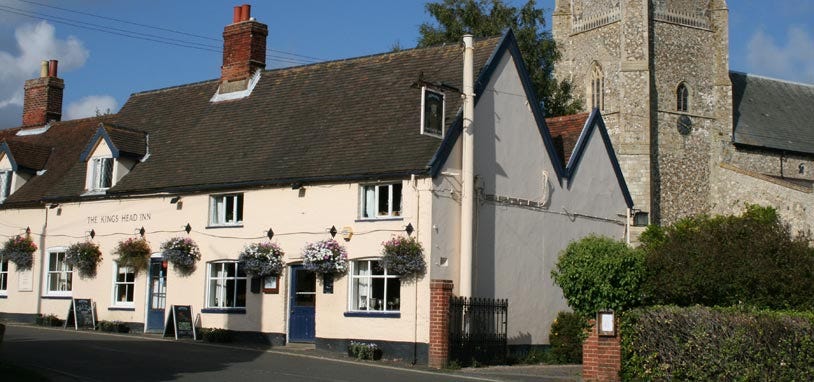In praise of foodie gentrification
Urban middle-class interlopers are changing traditional rural English food and drink: I went to the Suffolk coast to investigate. Plus: what I've been drinking this week




Ah, the village pub: you know, the one by the green, with a roaring fire and a genial landlord, where everybody knows you. Except I don’t want everyone to know my business, and the landlord of my village local was – at best – spectacularly grumpy. And the truth is that plenty of village pubs are generic and dull. But then the English countryside is a repository of many of the nation’s central myths, of which the ideal pub is just one.
Fortunately, I’m contemplating rural food and drink tradition from the agreeable vantage point of the King’s Head, Orford, over a bottle of Adnam’s Kobold lager. Indeed this village on the Suffolk coast is blessed with two nice pubs, with the Jolly Sailor down near the quay. I’ve been coming here with my family for 20 years: we love dogwalking on the wild shore, the castle, the fishing boats and the big East Anglian skies.
But how traditional is it? Orford’s prettiness and relative proximity to London make this second-home territory (though not for us). It’s not Islington-on-Sea posh like Aldeburgh or Walberswick, just to the north, but a cute two-bedroom cottage will still set you back nearly £400,000. And it boasts food and drink of the kind needed to sustain the London upper-middle classes on holiday.
Foremost amongst these offerings are those of the Pump Street Bakery, opened by tech executive Chris Brennan and daughter Joanna on the Market Square in 2010. The queues of middle-class folk in Hunter wellies and cycling lycra form on weekends before it opens: it sells out of almost everything daily. A bite of one of their cheese and ham croissants explains why. Meanwhile the bakery has opened a separate chocolate shop across the square. Forget popping into the village newsagent for a bar of Dairy Milk: here you can get single-estate Peru dark chocolate (“Tasting note: blackberry, warm spices, ripe peach.”)
There is more of a Suffolk flavour to fish specialist Pinney’s, something of an Orford institution, smoking fish they catch themselves and oysters they raise at their own beds down the coast in Butley. Their potted shrimp and hot-smoked salmon is traditional enough, the taramosalata less so – but equally irresistible. Pinney’s also own the best local fish restaurant, the excellent Butley Oysterage, on the Market Square.
And if you just fancy simple English fare, say sausage and beans? Butcher Andrew Page and his wife Diane at the Orford Meat Shed, in a quirky location down an alley among veg gardens, do sell very good local sausages and more. For the beans, there’s the Orford General Store on the green, though it must be said that it also offers a veg selection to put many London grocers to shame, to say nothing of guanciale, panettone and fresh mozzarella. Ever run out of ‘nduja while cooking on holiday? The General Store has you covered.
Then there are those pubs. Certainly you can get sausage and mash or fish and chips (though the latter at the Jolly Sailor comes in at a Notting Hill-style £19.95.) Or then again, the King’s Head also offers Thai Massaman curry, Italian sausage casserole and Mediterranean burgers.
Yes, it’s easy to poke fun at metropolitan foodies and their favoured haunts and ingredients: even I do so, and I am one. The Daily Mail would doubtless bemoan such colonisation of village England by fancy-pants Londoners. But it’s worth asking: what tradition did such metropolitan tastes actually displace?
Take the iconic village pub. George Orwell was writing about London rather than village pubs in his famous 1946 description of his local, The Moon Under Water, but he added mightily to the institution’s mythology. This pub was a place, he wrote, where “It is always quiet enough to talk... The house possesses neither a radio nor a piano… The barmaids know most of their customers by name… and they call everyone ‘dear,’ irrespective of age or sex.” Except, as Orwell admitted, the pub he described was fictitious, somewhere between a composite and a fantasy. Maurice Gorham’s classic hymn to the London pub, Back to the Local (1949) was more factually based – but scarcely a better guide to the reality since.
When I first started pub going, in the early 1980s, they were still focussed almost solely on drinking. The Trophy Bitter that I sipped of a sixth-form lunchtime in the York, in Exmouth, Devon, was rubbish but cost just 52p a pint (the equivalent of about £1.90 today – more affordable than the present day tab of £6-plus.) A request for a coffee would have been met with, at best, bemusement; if I’d asked for a latte in the York in 1981, they’d have looked at me blankly or assumed I was a lost foreign exchange student.
The only food usually available in pubs, and solely at lunchtimes, was sandwiches or the traditional “ploughman’s lunch’ – bread, cheese and pickles. Even that favourite was in fact a 1956 creation of marketing body the Cheese Bureau. And even the fanciest local watering hole where I grew up, Exton’s Nutwell Lodge, didn’t offer anything more gastronomic than crisps and peanuts in the evening (it’s now a Toby carvery – proof that standards can go down as well as up.)
As for local fish, despite Pinney’s having been going since the 1950s, seafood has a pretty patchy recent local tradition in England. Growing up in Devon in the 1970s and 80s, four miles from the sea, we rarely ate any fish other than cod, smoked haddock or plaice. You certainly couldn’t buy local shrimps, let alone razor clams or squid. Smoked salmon was a dish of unimaginable expense and sophistication.
Of course, the rubbishness of rural food in the 1970s was part of a dismal national phenomenon. Food rationing had ended barely two decades earlier (in 1954 for meat and cheese). As Elizabeth David later recalled, when writing about the “apricot, olives and butter, rice and lemons” of Mediterranean food, “in the England of 1947, those were dirty words.” Postwar cheese production in particular was almost entirely industrialised under the Milk Marketing Board (another energetic promoter of the ploughman’s lunch). Cheddar accounted for 70 per cent of British cheese consumption at one point, and many pre-war traditional cheeses never recovered. Meanwhile most British ice cream in my 70s childhood was made from vegetable fat.
But it wasn’t only the long shadow of wartime food to blame. English kitchens had already lost much of their connection to where their food came from. Britain having industrialised early meant that relatively few people worked on the land – only about five per cent of us even in 1950 (compared to around half of Spain’s population then.) You wouldn’t know it listening to the likes of the Countryside Alliance, but relatively few Britons within living memory have had much connection to the land or the sea. Today just 1.4 per cent work in agriculture or fishing (though last year it was a bit more in Suffolk, 2.3 per cent of residents.)
Combine that distance with an increasingly car-based economy since the 1970s, and the stranglehold of the big supermarkets on national tastes, and rural food traditions have been badly squeezed. Today Britons buy more than 95 per cent of their food in supermarkets: the four biggest - Tesco, Sainsbury’s, Asda and Aldi – have about 60 per cent of the grocery market. That includes the inhabitants of the countryside. Today, the hard truth is that much of southern rural England is essentially suburban, whatever stories it may tell itself.
I certainly feel for locals shut out of the housing market in places like Orford by well-heeled Londoners buying charming bolt holes. I don’t doubt that the prices of high-end Eccles cakes or artisanal cheeses look silly to anyone on a minimum wage. But those businesses are now an important part of the rural economy: Pump St Bakery employs up to 40 people in total.
No doubt 15 years ago, people in these parts would have been bemused if you’d wanted smashed avocado on toast with Piment d’Espelette for breakfast. I’m sorry, but I count the fact that you can now get it now, rather than a fry up, as progress. Although I’m sticking with the local beer in that village pub.
What I’ve been drinking this week
The Society’s Exhibition Côtes de Provence rosé 2024 - a classic Provence rosé from the Wine Society’s super-reliable Exhibition range - fresh, clean, red fruit and a touch of roundness - at a good price. I’d challenge anyone to taste it blind against much pricier Whispering Angel and not prefer this one (£12.50.)
Sendiäna 2014, Lebanon - this red combines Grenache, Syrah, and Merlot from the St Jean monastery’s vines on Mount Lebanon with Cabernet Sauvignon from the Bekaa valley. Sweet, spicy fruit, smooth tannins, good depth, nicely balanced - lovely (Cellar Door Wines, Peter Osborne Fine Wines, from £18.95.)
Bedoba Saperavi 2022, Kakheti - this Georgian red is rich in the style you’d expect - it’s part made in traditional earthenware qvevri - without being jammy. Bursting with sweet, dark, juicy fruit, harmonious with supple tannins, though without quite as much length as I’d expected (Winesquare, Divine Fine Wines, Wild and Lees and elsewhere, from £15.30.)




